
Dr. Jin Gu, Kang and his team at the Nanophotonics Research Center at the Korea Institute of Science and Technology (KIST) have developed a colorful radiation-cooling liquid crystal material that can cool without external power while simultaneously emitting color. The work is published in the Chemical Engineering Journal.
Radiative cooling is a powerless cooling technology that releases infrared radiation as heat throug...
Read More









Recent Comments